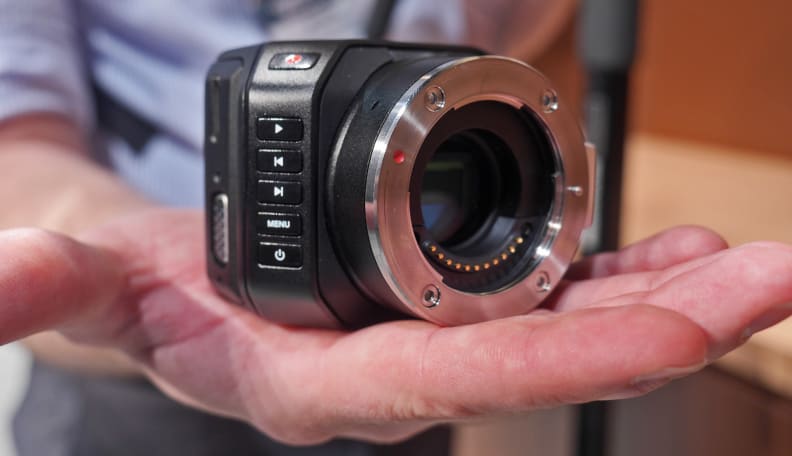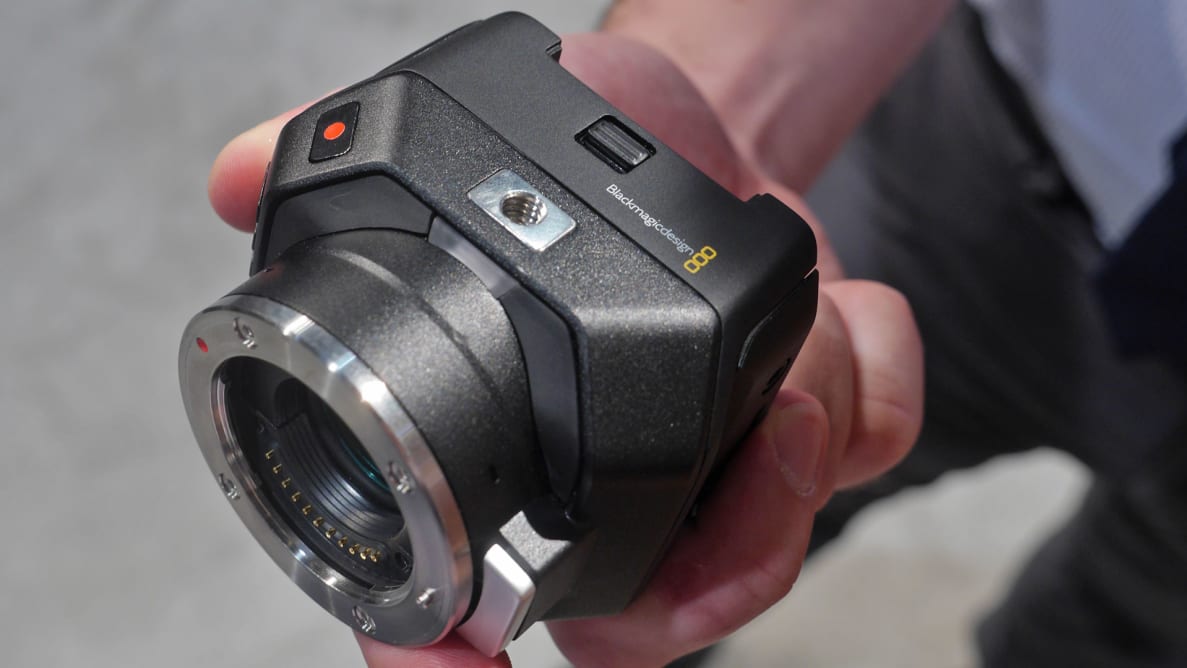Blackmagic's latest camera has the same guts as the Pocket Cinema Camera: a Micro Four Thirds interchangeable lens mount, a Super 16 sensor, and a $995 price tag when it starts shipping in July. But where the Pocket Cinema Camera was pocketable, the Micro Cinema Camera is even smaller—it's designed to be worn on a helmet, flown by a drone, and taken almost anywhere.
The Micro Cinema Camera shoots Full HD 1080p video using CinemaDNG RAW or Apple ProRes compression, and it has Blackmagic's customary list of frame rate options. You can shoot 23.98p, 24p, 25p, 29.97p, or 30p using a global shutter, and you can go up to 50p and 60p using a rolling shutter. Just like the Pocket Cinema Camera, Blackmagic touts the Micro Cinema Camera as being capable of 13 stops of dynamic range.
With these impressive specs, you could call the Micro Cinema Camera a GoPro for pros. However, with a price that's roughly double GoPro's top-of-the-line Hero4, the Micro Cinema Camera is more of an investment. In addition to the grand you'll spend on the camera itself, you'll need to shell out more for lenses, controls, mounts, and accessories. Unlike a GoPro, the Micro Cinema Camera is not ready to shoot out of the box, and that's one of the main reasons it will appeal more to pros than general consumers.
{{brightcove '4170904179001'}}
Design
Without a lens, the Micro Cinema Camera is essentially a little box—more like a GoPro on steroids than a shrunken Blackmagic Pocket Cinema Camera. It's also very light, weighing just 10.65 ounces without a battery pack.
To be clear, that's about twice the weight of a GoPro Hero4 inside its waterproof case, making the Micro Cinema Camera hefty by comparison. But that heft is due to a strong magnesium shell and an active Micro Four Thirds lens mount—two features a GoPro lacks.
This little video camera can be used with any MFT lens (as well as lenses from other mounts, if you get the right adapter). We saw it loaded with a 14mm pancake from Panasonic that barely added any weight or girth to the tiny device. Obviously, using the camera with huge, heavy lenses will affect its portability (drones can only lift so much), but there are plenty of light, compact MFT lenses out there.
{{ photo_gallery "blackmagic" }}
The camera has three tripod mounts on its base and one on top, making it easily mountable to any device that has a standard tripod screw or plate. The battery slot on the back works with Canon-compatible LP-E6 batteries, which are easy to find online and give you up to 90 minutes of recording time, according to Blackmagic.
{{amazon name="GoPro HERO4 BLACK 4K Action Camera", asin="B00NIYNUF2", align="right"}} Each side of the Micro Cinema Camera has a column of vents that give the device an aura of brute power. There are a series buttons on one side (playback controls and a menu button), as well as a few ports: 3.5mm mic jack, SD card slot, HDMI, and a customizable expansion port, which we'll explain in the next section.
You may also notice that the Micro Cinema Camera has no LCD display, which means you can't monitor what you're shooting unless you connect the camera to an external device (via HDMI or the expansion port). It also lacks built-in WiFi, so you can't monitor recording on your smartphone like you can with a GoPro and virtually every other action cam on the market.
Ports & Connectivity
The Micro Cinema Camera's connectivity features are unlike any other camera I've ever seen. This isn't necessarily a good thing—the strange setup is sure to appeal to some, but it's bound to annoy plenty of others.
Here's how it works. The camera has what Blackmagic is calling an "expansion port" that's based on a standard DB-HD15 pin connector. That's the same port as a standard VGA connection on a computer monitor, but here it's being used in an entirely different manner.
Each pin in the port controls a different signal (like power, video output, remote operation, etc.), which allows you to connect a wide variety of cables. If you can't find a cable for your specific needs, Blackmagic recommends building and soldering your own (seriously). This idea may appeal to some—particularly all those engineers-turned-filmmakers out there—but it's certainly not for everyone.

The expansion port is located beneath the HDMI output, and it's one of the Micro Cinema Camera's key features.
Through the expansion port, Blackmagic says you could attach a 5-volt DC power input, a BNC genlock connector, a composite video output, a LANC wired remote, and two remote control systems: PWM Analog Servo and Futaba S.Bus Digital Servo.
Those last two control systems are both the most interesting and the most complicated. PWM Analog Servo Controls are based on common control schemes found on model airplanes. This would theoretically enable you to map the Micro Cinema Camera's controls to a model airplane controller and operate the camera settings—things like focus, iris, and shutter speed—remotely. However, PWM is a 4-channel Analog system, so you'd be limited to mapping four camera controls to your remote.

The Futaba S.Bus control system allows you to map camera controls to a model airplane remote.
Futaba's S.Bus is similar, but it's a far more advanced, 18-channel digital control system. That means you can map a lot more functions to a remote control than you can with PWM.
While these control schemes sound impressive, and maybe even fun to construct, it makes it clear that the Micro Cinema Camera won't appeal to everybody. Like the full-size Blackmagic Cinema Camera before it, this device requires a lot of tinkering and extra tools to get its full potential. Instead of the grips and tripods required to make the original Cinema Camera functional, the Micro Cinema Camera requires remote controls, soldered cables, and mounting supplies before the fun starts.
Conclusion
As impressive as the Micro Cinema Camera is, I can't help but wish it offered more. Built-in WiFi with smartphone monitoring would open it up to a broader audience—especially those who aren't excited about shelling out cash for a model airplane controller. The unique expansion port may sound exciting to people who love DIY projects, but it won't appeal to the masses, or some professionals.

There's a lot to love about the Micro Cinema Camera, but not everyone is going to appreciate its control system.
That's where the Micro Cinema Camera clearly butts heads with the GoPros of the world. With all its power and customizability, this camera lacks the ease of use of a consumer action cam. I love the Micro Four Thirds lens mount, the recording options, the design, and the build quality, but I don't love all the extra supplies and effort needed to get the most out of the Micro Cinema Camera.
This won't be a deal-breaker for everyone. It just all depends on how much time and money you're willing to invest in this system (or how much compatible equipment you already own). Either way, I'm truly excited to see how this camera sells, and I can't wait to see the videos people create with it.
Related Video
{{brightcove '2623023981001'}}
Meet the tester
Jeremy is the video expert of our imaging team and Reviewed.com's head of video production. Originally from Pennsylvania and upstate NY, he graduated from Bard college with a degree in film and electronic media. He has been living and working in New England since 2005.
Checking our work.
Our team is here for one purpose: to help you buy the best stuff and love what you own. Our writers, editors, and lab technicians obsess over the products we cover to make sure you're confident and satisfied. Have a different opinion about something we recommend? Email us and we'll compare notes.
Shoot us an email




